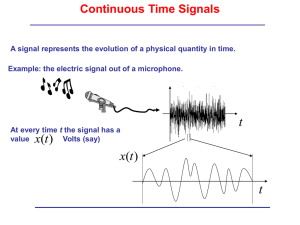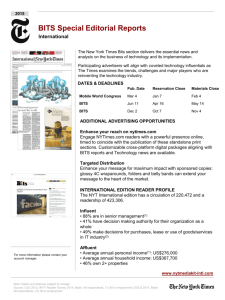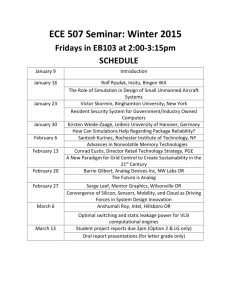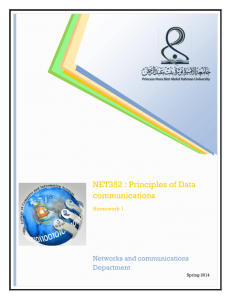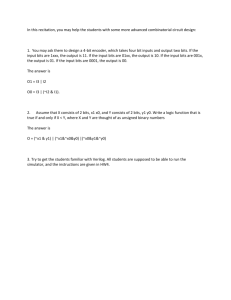Comparison of practical feedback algorithms for multiuser MIMO Please share
advertisement
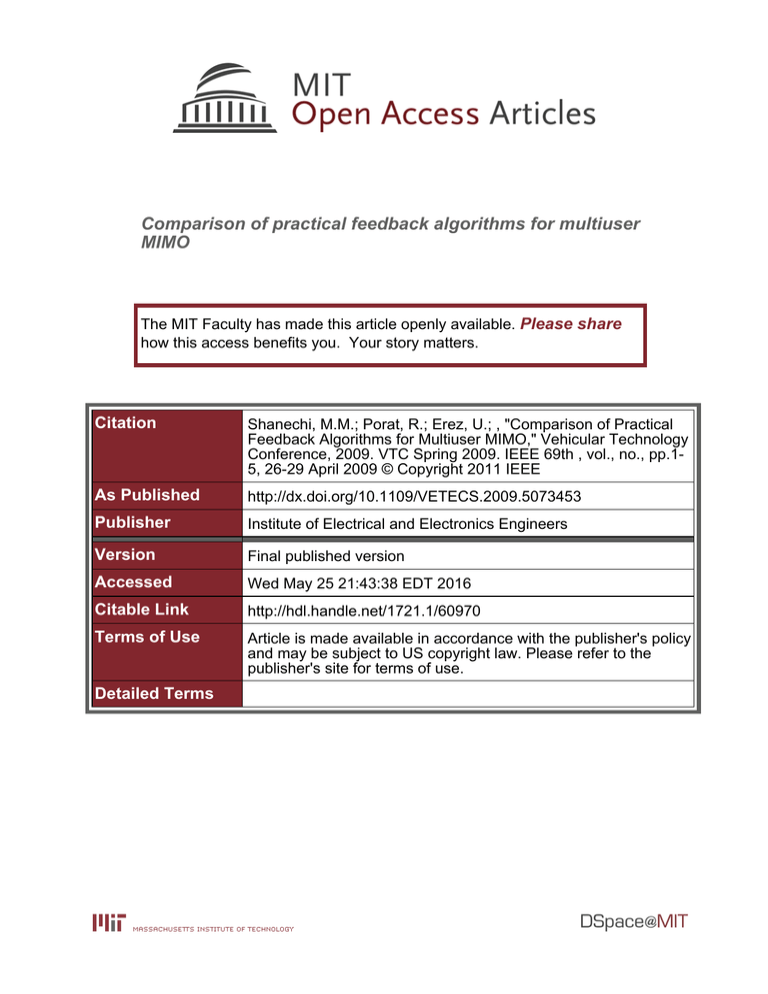
Comparison of practical feedback algorithms for multiuser
MIMO
The MIT Faculty has made this article openly available. Please share
how this access benefits you. Your story matters.
Citation
Shanechi, M.M.; Porat, R.; Erez, U.; , "Comparison of Practical
Feedback Algorithms for Multiuser MIMO," Vehicular Technology
Conference, 2009. VTC Spring 2009. IEEE 69th , vol., no., pp.15, 26-29 April 2009 © Copyright 2011 IEEE
As Published
http://dx.doi.org/10.1109/VETECS.2009.5073453
Publisher
Institute of Electrical and Electronics Engineers
Version
Final published version
Accessed
Wed May 25 21:43:38 EDT 2016
Citable Link
http://hdl.handle.net/1721.1/60970
Terms of Use
Article is made available in accordance with the publisher's policy
and may be subject to US copyright law. Please refer to the
publisher's site for terms of use.
Detailed Terms
Comparison of Practical Feedback Algorithms for
Multiuser MIMO
Maryam Modir Shanechi
Ron Porat
Uri Erez
Dept. EECS, MIT
Cambridge, MA
Email: shanechi@mit.edu
NextWave Wireless
San Diego, CA
Email: rporat@nextwave.com
Tel Aviv University
Ramat Aviv, Israel
Email: uri@eng.tau.ac.il
Abstract— We consider the problem of channel state information (CSI) transmission on a fast feedback link for a multiuser MIMO system.We examine the relative merits of channel
feedback schemes based on Shannon’s source-channel separation
theorem and non-separation based schemes and show that the
latter are preferable in this application. For the non-separation
based schemes, we first consider a simple analog transmission
and then develop a hybrid digital-analog transmission scheme
which quantizes the CSI using a few bits and sends these bits and
also the quantization error using analog transmission. We show
that the hybrid scheme achieves a higher throughput compared
to both analog and digital transmissions and has a much lower
computational complexity compared to a digital scheme.
I. I NTRODUCTION
In closed loop multiple-input multiple-output (MIMO) cellular systems, the base station must obtain knowledge of the
downlink channel state information (CSI). For single user
MIMO applications, this information is used to direct the
transmitted power towards the mobile station and provides
an SNR gain which results in significant throughput gains.
For multiuser (MU) MIMO applications on the other hand,
accurate CSI at the transmitter (CSIT) is much more crucial
since having approximate CSIT results in residual interference,
incurs a significant loss in throughput, and does not achieve the
full multiplexing gain [1]. Obtaining accurate CSIT at the base
station is a difficult problem especially in frequency-division
duplex (FDD) systems, where channel reciprocity cannot be
used and the CSI must be fed back to the base station on a
fast feedback link. Hence, designing good channel feedback
coding algorithms are of significant interest in these systems.
The channel state information, e.g., the channel matrix, is
an analog source in nature. The goal of the feedback algorithm
is to encode this information at the mobile station to enable
its reconstruction with minimum distortion at the base station.
Thus, the feedback coding problem is a joint source-channel
coding problem. In addition, the requirement of low delay
dictates the use of short block lengths.
There are two main approaches one could take in designing
the CSI feedback link. One that has traditionally received most
attention is based on Shannon’s source-channel separation
theorem that proves the asymptotic optimality of separate
source and channel coding under certain conditions. In these
schemes, which we refer to as “digital schemes”, the source
(CSI) is first quantized and then the quantization bits are coded
using a channel code to recover the quantized source with
low error probability at the receiver. The main drawback of a
digital scheme however, is the threshold effect which means
that the system achieves the desired performance only at the
designed SNR. At lower SNR, system performance is severely
sacrificed and at higher SNR, it does not improve. Hence this
approach is suboptimal in a scenario where the exact SNR
is known only to lie in some range. Another shortcoming of
this approach even for a single (and known) SNR is that long
source and channel codes are needed to achieve the optimal
performance which is not possible over a fast feedback link.
The other approach one could take to solve this problem
is a joint source-channel approach that does not follow the
separation principle. The simplest example of such a scheme
is analog transmission that allows for a graceful degradation
of performance at low SNR and does not saturate at high
SNR. However, while it is optimal (when the criterion is that
of mean-squared error (MSE)) for transmitting a Gaussian
source over a Gaussian channel of equal bandwidth, it is
suboptimal when the bandwidths are different. Nonetheless,
more advanced joint source-channel coding schemes have been
devised that make better use of the available bandwidth than
purely analog transmission and at the same time are more
robust than separate source and channel coding (over a channel
with unknown SNR) and offer better performance for a given
delay [2] [3] [4].
Here, we examine the relative merits of separation based
and non-separation based approaches in the context of MIMO
channel feedback, and observe that the latter are preferable
in practical MIMO systems. We show that these approaches
work well in MU-MIMO systems without exact knowledge of
the SNR, which is needed in a digital approach as shown in
[5]. They also incur a much smaller computational complexity
as compared to a digital scheme. In particular, we develop
a hybrid digital-analog source-channel code for the feedback
link and show that it performs close to the perfect CSIT case.
II. C HANNEL M ODEL AND T RANSMISSION S CHEME
We consider a MU-MIMO system with K users each with
Nr antennas and a base station (transmitter) with Nt antennas.
The downlink channel model of interest takes the form
yk = Hk x + wk , k = 1, · · · , K
978-1-4244-2517-4/09/$20.00 ©2009 IEEE
(1)
1
where channel input x and channel output at user k, yk , are
Nt - and Nr -dimensional vectors, respectively, and where the
associated noise vectors wk are CN(0, N0 I) and independent.
Here, Hk is the channel matrix from the base station to the kth
user whose elements we assume are CN(0, 1) and independent,
i.e., Rayleigh faded. The channel input is constrained to an
average power P , i.e., E[|x|2 ] = P and hence for downlink,
SNR = P/N0 . We assume that users have perfect CSI at their
receivers (CSIR). In this work we set the number of users
equal to the number of transmit antennas which is the regime
of interest for most next generation wireless systems [5].
For concreteness, we study the performance of the feedback
schemes for a specific (zero-forcing based) transmission approach (similar to the one in [6]), but none of the schemes
is specifically tailored to this approach. Our transmission
scheme is based on sending a single data stream to each user
using a simple regularized zero-forcing (ZF) beamforming that
performs better than a ZF beamforming [7]. Our scheme is
hence similar to that in [6]. Assuming K active users in the
system and denoting the strongest right singular vector of the
kth user by v(k) , the regularized ZF beamformer for user k,
fk , is given by the normalized kth column of the matrix
−1
K
Ω = Γ† ΓΓ† +
I
(2)
SNR
where Γ = [v(1) , · · · , v(k) ]† . Hence, fk = ω k /|ω k |, where
ω k is the kth column of Ω. ZF beamforming, even though
suboptimal, offers a good balance between performance and
complexity, and is reasonably close to capacity (achieved by
dirty paper coding) when combined with user selection [8].
In the case of channel feedback, Γ in (2) is replaced by the
estimated matrix from this feedback, Γ̂ = [v̂(1) , · · · , v̂(k) ]† .
We assume equal power allocation is used at the base station
for all active users and hence each user only feeds back its
strongest right eigenvector.
At the receiver, each user exploits a minimum mean-square
error (MMSE) receiver to estimate its data as was done in [6],
which further mitigates the residual interference from the other
users. To concentrate on the effect of feedback schemes, we
assume that the receivers have perfect CSIR of the interference
terms which could be obtained using a dedicated pilot training
period in the downlink. At the kth user, the MMSE receiver
is thus given by
⎞−1
⎛
P
Hk fi fi† H†k ⎠ Hk fk
gk = ⎝I +
KN0
i=k
which results in the kth user SINR of
⎛
⎞−1
P † †⎝
P
f H
Hk fi fi† H†k ⎠ Hk fk
SINRk =
I+
KN0 k k
KN0
i=k
Finally,
K the ergodic system throughput is given by R =
EH [ k=1 log2 (1 + SINRk )].
We implement the transmission scheme both with and
without user selection where the user selection is assumed to
be done with perfect knowledge (genie-aided) of the downlink
channels and an exhaustive search. Thus, it gives an upper
bound on the gain of user selection algorithms.
We compare the different feedback coding algorithms in
the above multiuser setup and in terms of the overall system
throughput. Each user transmits its Nt dimensional CSI over
βf b Nt uses of the uplink channel, where βf b is the bandwidth
expansion factor. In this work, we consider both an AWGN and
a more realistic slow faded uplink channel generated according
to the ITU Pedestrian B channel in [9]. We assume an uplink
SNR of SNRU L with an SNR offset between downlink and
uplink of ΔSNR dB= SNR dB−SNRU L dB.
III. S EPARATION BASED A PPROACHES
Separation based or digital approaches for channel feedback
have received the greatest traction so far in the literature [5]
[10] [8]. It was shown in [8] that using a digital approach and
any fixed number of feedback bits per user and without user selection, the overall system throughput is bounded which results
in substantial throughput loss. Fig. 3(a) shows the perfect CSIT
and the 4 bit digital ZF throughputs for a 1×4 channel with an
AWGN uplink and no selection (details in Section V). We have
also shown upper-bounds on the performance of 8 and 16 bits
digital approaches that were obtained by introducing noise on
v(k) s according to the quantization error distribution derived
in [8] and assuming error-free transmission of the quantization
bits (hence loose at low SNR). It can easily be seen that system
throughput saturates with increasing SNR. This saturation is
the result of the system becoming interference limited [5].
It was shown in [5] that to achieve the full multiplexing gain
in a digital approach, number of feedback bits per user should
be increased at least with a factor of (Nt − 1) log2 (SNR). Indeed, for 1 antenna users, using a random vector quantizer and
uncoded quadrature amplitude modulation (QAM) achieves a
performance close to perfect CSIT if and only if the number
of feedback bits is increased this way. [5]
It is important to note however, that in terms of practical
implementation, this scheme has the following difficulties
making it of limited use in wireless systems. First, the quantization codebook has to be decided based on SNR. In many
applications this SNR is known only to lie in some range and
the mobile station does not have its accurate estimate. Since
the performance of the system strongly depends on the correct
choice of the number of feedback bits, this incurs a significant
loss in practical systems and leads to a conservative design.
Moreover, the number of bits required for this digital
scheme is very large for medium and high SNR. For example,
for a 4 antenna base station and 1 antenna users at an SNR
of 20dB, at least 20 quantization bits are needed per user
[5]. This requires the design of multiple (for different SNRs)
good quantization codebooks of very large cardinality which
is a difficult problem. Having a large codebook also incurs
a large computational complexity on the users for codeword
selection and thus codebooks with large cardinality would
need to be highly structured. These limitations of separationbased approaches in the context of MIMO channel feedback,
2
V
Quantizer
Alignment
V̄
(b1 , · · · , bB )
Algebraic Code
Index Lookup
(c1 , · · · , cn )
an equal phase rotation on every element of v(k) which
does not affect its direction), the goal is to find the unitary
(k)
transformation matrix Φopt that minimizes the variance of
the error term, i.e., solving for each user
(k)
Φopt = arg min ||V̄k − Vk Φ||2F
Φ∈U
Ṽ
Fig. 1.
− E
Hybrid Feedback Algorithm.
motivate the study and design of feedback coding algorithms
which do not adhere to the separation principle.
IV. N ON -S EPARATION BASED A PPROACHES
Here we look at two non-separation based schemes for channel feedback. We first look at an analog transmission scheme
and then develop a special hybrid digital-analog feedback
algorithm motivated by the source-channel codes in [2]. We
will show that both schemes are preferable to a digital scheme
in a practical setting and moreover the hybrid algorithm has
an advantage over a pure analog approach and could be used
to close the gap further with respect to the perfect CSIT case.
A. Analog Feedback Algorithm
In analog transmission, the elements of the CSI are sent
over the channel using simple unquantized QAM. For the
bandwidth expansion case, i.e., βf b > 1, the same analog
signal is repeated over the channel. At the receiver an MMSE
estimator obtains the best estimate of the CSI symbols.
B. Hybrid Feedback Algorithm
Here, we develop the hybrid feedback algorithm. This
algorithm is based on first quantizing the CSI using a few
bits, sending those using a short (e.g., algebraic) code and
then sending the quantization error using analog transmission.
Here we explain the algorithm based on feeding back the right
(k)
(k)
singular vectors of each user channel, Vk = [v1 · · · vr ],
where r is the transmission rank. Note that this algorithm is
applicable to any other channel feedback quantity conditioned
on the existence of good vector quantizers for it. The hybrid
scheme is shown in Fig. 1 and proceeds as follows:
(1) Decide on the transmission rank, ropt , based on the
criterion of interest, e.g., based on the MU transmission
algorithm (rank 1 in our MU transmission scheme).
(k)
(k)
(2) For each user, quantize Vk = [v1 · · · vropt ] using a B bit
codebook, Q = {Q1 , · · · , Q2B }, with the mapping criterion of interest such as maximum correlation criterion
[10], i.e., V̄k = arg maxi ||Q†i Vk ||F . Denote the resulting
(k)
(k)
quantization bits by (b1 , · · · , bB ).
(3) Align Vk to V̄k by performing a unitary transformation
from right on Vk . Since the transmission scheme (and
capacity of the channel) is invariant to a unitary transformation from right on Vk for any user (for example
for the one dimensional rank 1 transmission this is just
(3)
where U is the set of all unitary matrices. We can prove
(k)
†
that this transformation is given by Φopt = Vcorr Ucorr
where Vcorr and Ucorr are the right and left singular vectors
of the correlation matrix V̄k† Vk , respectively, i.e., V̄k† Vk =
(k)
†
Ucorr ΣVcorr
. We denote the aligned Vk by Ṽk = Vk Φopt .
(k)
For example for our rank 1 transmission, Φopt is just a
phase rotation on every element by −∠(v̄(k)† v(k) ).
(4) Construct the correction or error signal, Ek = Ṽk − V̄k .
(5) Possibly use a short (n, B, d) algebraic code such as a
Reed Muller code to encode the B quantization bits for
each user into a codeword (c1 , · · · , cn ).
(6) Send Ek and (c1 , · · · , cn ) for each user over the uplink
channel. This should be done by splitting the resources
in the channel, i.e., power and bandwidth, between the
analog error signal and the digital code depending on the
application. We will show an example of such splitting
and the corresponding receiver, using the uplink control
channel in the IEEE802.16e standard [11].
At the base station, digital data is decoded using a maximum
likelihood (ML) decoder. This will not incur much complexity
since the number of quantization bits is small. The analog error
signal is reconstructed using an MMSE estimator. Denoting
the estimated Ek by Êk and assuming correct decoding of
the digital quantized data, V̂k for user k is reconstructed as
V̂k = V̄k + Êk .
V. S IMULATIONS
Here we implement the digital, analog, and hybrid feedback
algorithms in two scenarios: First, in a simple case where the
uplink channel is AWGN and the users each have 1 antenna.
Then in the realistic case where the uplink channel is faded
and modeled using the ITU Pedestrian B channel in [9] and
each user has 2 receive antennas and transmits with 1 antenna
in the uplink (as is the case in most wireless devices).
A. Simulation Setup
We use the uplink control channel in the IEEE 802.16
standard [11] for our implementation. This channel consists
of basic units, called tiles, that each consists of 12 uses of the
uplink channel, 4 for pilots and 8 for data as shown in Fig. 2.
For the case of MU-MIMO implementation, rank 1 transmission is used and hence each user’s feedback consists of 4
symbols of v(k) . Hence each tile use of the control channel
corresponds to a βf b = 2. In the hybrid scheme, the digital
data is constructed using 4 bit codebook quantizers. To encode
the 4 bits, we use the (8,4,4) extended Hamming code. These
8 coded bits are then placed on 4 (complex) channel uses
within a tile and the other 4 channel uses are used for analog
transmission of the error signal as shown in Fig. 2.
3
11111111111111
0000000
00000000000000
1111111
0000000
00000001111111
1111111
0000000
1111111
0000000
Pilot
Pilot 1111111
0000000
1111111
1111111
0000000
0000000
00000001111111
1111111
Time
00000001111111
1111111
0000000
1111111
00000
11111
0000000
1111111
0000000
0000000
1111111
00000
11111
0000000
1111111
0000000
1111111
0000000
1111111
1111111
0000000
00000Digital
11111
0000000
1111111
0000000
1111111
0000000
1111111
0000000
1111111
00000
11111
0000000
1111111
0000000
1111111
0000000
1111111
0000000
1111111
00000
11111
Legend
00000
11111
0000000
1111111
0000000
1111111
00000001111111
1111111
00000001111111
1111111
00000
11111
0000000
0000000
1111111
0000000
0000000
1111111
0000000
00000
11111
00000001111111
1111111
0000000
1111111
0000000
1111111
00000Analog
11111
0000000
1111111
0000000
1111111
0000000
1111111
0000000
1111111
0000000
1111111
0000000
1111111
Pilot
Pilot 1111111
0000000
1111111
0000000
0000000
00000001111111
1111111
Frequency
Fig. 2.
Tile Assignment.
We satisfy the uplink power constraint of PU L per channel
use by scaling each tile with a factor α which depends on the
analog error power in that tile. However since the analog error
variance (average power) is much smaller than the constant
digital power of 1 per symbol (QPSK constellation), we first
boost the analog error signal by a known factor γ which we
optimize over. Hence, the power equation for a tile becomes
PU L = (α2 /8)(Pdigital +γ 2 ||E||2F ), where Pdigital = 4 (4 QPSK
symbols) and from which we can obtain α for any tile. At the
receiver we estimate α (required to retrieve the magnitude of
analog error) by finding the ratio of pilot to digital average
power since pilots all have power 1.
The encoding in the pure 4 bits digital scheme is the same
as the digital part of the hybrid scheme discussed above. For
both the pure analog and pure digital schemes, each symbol of
the feedback is just repeated twice within a tile and the right
power scaling is used. Since here only the direction matters,
there is no need to estimate this factor at the base station.
B. Simulation Results
Fig. 3 and 4 compare the overall throughputs of the analog
and hybrid schemes in the 2 simulation scenarios for ΔSNR =
6dB and 15dB, with or without user selection for βf b = 2. In
these figures we also show an upperbound on the performance
of the system, assuming error free transmission at capacity on
the uplink channel. To get this bound we introduced noise
on the v(k) s according to the quantization error distribution
derived in [8] with the number of quantization bits equal to
the total uplink capacity of a tile (βf b = 2). This bound shows
the best one can do with any feedback algorithm and long
block lengths. For reference, we also show the performance
of a 4 bit digital scheme and upperbounds on the performance
of fixed digital approaches with 8 and 16bits.
Fig. 3 compares the different algorithms for the first scenario
without user selection. At ΔSNR = 6dB, both analog and
hybrid transmissions perform very close to perfect CSIT. Note
that hybrid transmission performs better than analog and this
improvement becomes more apparent at larger ΔSNR. Also
the performance of the hybrid algorithm is very close to
the upperbound for up to about 15dB even for ΔSNR =
15dB. Fig. 4 similarly shows the throughputs for the second
simulation scenario with and without user selection. We again
observe that both analog and hybrid perform very close to
perfect CSIT and hybrid performs better than analog as ΔSNR
grows. Intuitively, the improvement of hybrid over analog
repetition results from the fact that the analog error has a much
lower variance (about 5dB lower) than the signal itself. Hence
sending the error as opposed to repeating the signal over the
same channel results in a lower MSE in signal reconstruction.
We can also see that the digital approach with any fixed
number of bits and no user selection saturates in both simulation scenarios as expected [8], and with user selection, even
though it does not saturate, it still has a substantial loss as
compared to perfect CSIT. Note that (c.f. Section III) in order
to avoid saturation and have a good performance, the number
of bits should grow as (Nt −1) log(SNR). As discussed before,
SNR is unknown and users may not have a good estimate of it.
Also, in practice a limited number of codebooks (with different
sizes) would be used and thus a single codebook would need
to be used for a range of SNRs, limiting the granularity
of the number of operational SNR points. Both the SNR
estimation error and limited SNR granularity, will degrade the
performance of such a digital approach. We conjecture that in
practice, the loss from these factors will be more pronounced
than that associated with even using a simple analog scheme.
Moreover, by using the hybrid scheme we can further reduce
the gap in performance from the perfect CSIT.
In terms of complexity, the large codebooks needed for
a digital scheme will incur a much greater computational
complexity in the system as compared to a simple analog
or hybrid scheme. Note that in the hybrid scheme a fixed
small (4 bits) codebook is used and the additional accuracy
is obtained by sending a correction analog signal and thus the
hybrid approach does not suffer from the disadvantages of a
digital approach with variable codebook size.
VI. C ONCLUSIONS
We examined the relative merits of the separation-based and
non-separation based transmission schemes in the context of
MU-MIMO channel feedback and showed that non-separation
based schemes are preferable for this application. Among
non-separation schemes, we developed a hybrid digital-analog
feedback scheme that achieves higher throughputs compared
to pure analog or digital schemes and also has a much smaller
computational complexity compared to a digital approach.
R EFERENCES
[1] A. Lapidoth, S. Shamai(Shitz), and M. A. Wigger, “On the capacity
of fading MIMO broadcast channels with imperfect transmitter sideinformation,” IEEE Trans. Inform. Theory, May 2006, submitted. Available at http://arxiv.org/abs/cs.IT/0605079.
[2] U. Mittal and N. Phamdo, “Hybrid digital-analog (HDA) joint
sourcechannel codes for broadcasting and robust communications,” IEEE
Trans. Inform. Theory, vol. 48, no. 5, pp. 1082–1102, May 2002.
[3] N. Phamdo, N. Farvardin, and T. Moriya, “A unified approach to treestructured and multistage vector quantization for noisy channels,” IEEE
Trans. Inform. Theory, vol. 39, no. 2, pp. 835–850, May 1993.
[4] M. Wang and T. R. Fischer, “Trellis-coded quantization designed
for noisy channels,” IEEE Trans. Inform. Theory, vol. 40, no. 6, p.
17921802, Nov. 1994.
[5] G. Caire, N. Jindal, M. Kobayashi, and N. Ravindran, “Multiuser MIMO
downlink made practical: Achievable rates with simple channel state
estimation and feedback schemes,” IEEE Trans. Inform. Theory, Nov.
2007, submitted for publication. See http://arxiv.org/abs/0711.2642.
[6] F. Boccardi, H. Huang, and M. Trivellato, “Multiuser eigenmode transmission for MIMO broadcast channels with limited feedback,” in SPAWC
Workshop, 2007.
4
25
25
Perfect CSIT
Upper Bound, β =2
Perfect CSIT
Upper Bound, β =2
No User
Selection
fb
fb
20
Hybrid, β =2
fb
20
Analog, β =2
Analog, β =2
fb
Digital 4 bits, βfb=2
Sum Rate [bits/s/Hz]
Sum Rate [bits/s/Hz]
fb
Fixed Digital Upper Bounds
15
16 bits UB
10
8 bits UB
5
0
Digital 4 bits, βfb=2
Fixed Digital Upper Bound
15
10
8 bits UB
5
5
10
15
SNR [dB]
20
0
25
5
10
15
SNR [dB]
(a)
Perfect CSIT
Upper Bound, β =2
25
Perfect CSIT
Upper Bound, β =2
25
Hybrid, βfb=2
Analog, β =2
16 bits UB
fb
Fixed Digital Upper Bounds
15
8 bits UB
10
fb
20
Sum Rate [bits/s/Hz]
Sum Rate [bits/s/Hz]
Analog, β =2
fb
Digital 4 bits, β =2
5
Digital 4 bits, β =2
fb
Fixed Digital Upper Bound
15
8 bits UB
10
5
5
10
15
SNR [dB]
20
0
25
5
10
15
SNR [dB]
(a)
Perfect CSIT
Upper Bound, β =2
25
With User
Selection
fb
Perfect CSIT
Upper Bound, β =2
25
25
With User
Selection
fb
Hybrid, β =2
fb
fb
Analog, βfb=2
20
20
(b)
Hybrid, β =2
16 bits UB
Digital 4 bits, β =2
fb
Fixed Digital Upper Bounds
Analog, βfb=2
20
Sum Rate [bits/s/Hz]
Sum Rate [bits/s/Hz]
No User
Selection
fb
Hybrid, βfb=2
8 bits UB
15
10
5
0
25
(b)
No User
Selection
fb
20
20
1 × 4 channel without user selection and with (a) ΔSNR = 6dB (b) ΔSNR = 15dB.
Fig. 3.
0
No User
Selection
fb
Hybrid, β =2
Digital 4 bits, β =2
fb
8 bits UB
Fixed Digital Upper Bound
15
10
5
5
10
15
SNR [dB]
20
25
(c)
0
5
10
15
SNR [dB]
20
25
(d)
Fig. 4. 2 × 4 channel with (a) no user selection and ΔSNR = 6dB (b) no user selection and ΔSNR = 15dB (c) user selection and ΔSNR = 6dB (d)
user selection and ΔSNR = 15dB.
[7] C. B. Peel, B. M. Hochwald, and A. L. Swindlehurst, “A vectorperturbation technique for near-capacity multiantenna multiuser communication Part I: Channel inversion and regularization,” IEEE Trans.
Commun., vol. 53, no. 1, pp. 195–202, Jan. 2005.
[8] N. Jindal, “MIMO broadcast channels with finite rate feedback,” IEEE
Trans. Inform. Theory, vol. 52, no. 11, pp. 5045–5059, Nov. 2006.
[9] “Recommendation ITU-R M.1225. available at www.itu.int/itu-r/studygroups/docs.”
[10] D. Love and J. Robert W. Heath, “Limited feedback unitary precoding
for spatial multiplexing systems,” IEEE Trans. Inform. Theory, vol. 51,
no. 8, pp. 2967–2976, Aug. 2005.
[11] “IEEE P802.16Rev2/D6 July 2008.”
5
